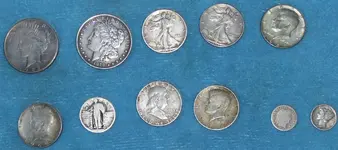Before World War II, and even a little afterwards, V was used in place of U in formal writing. It was considered very formal, and sometimes you'll see old buildings that have their names spelled with a V instead of a U. Like "MVSEVM." The two letters have been used interchangeably under different spelling rules over the centuries. The most well-known example in the complex U-V history was the practice of using U in the middle of a word, and V at the beginning. "I haue an olde farthing I just vnearthed." Elizabethan writers, especially Spenser, were notorious for adhering to the strict U-V rules of the day. Old alphabets sometimes had V preceeding U, and things were pretty much confusing from the Middle Ages until the 1700's. I don't know for sure, but I imagine that Samuel Johnson helped to standardize the spelling of using V for a consonant sound, and U for a vowel sound.
The direction which the effigy of Lady Liberty faces usually alternates with each new coin design. The precedent was established by the British Royal Mint, which alternates the direction of the King or Queen with each subsequent monarch. If history holds true, the next King of England will face the opposite direction of the current Queen. In more recent times, the Mint has allowed this practice to become a secondary consideration when designing new coins.
Kennedy was assassinated in November, 1963. In 1964 he appeared on the half dollar. 1964 was the last year that halves, quarters, and dimes were made of 90% silver. In 1965, quarters and dimes were made with a copper-nickel sandwich, but the half dollars continued to be made of silver---40% silver, not 90%---until 1970, after which the composition was changed to copper-nickel.
The V was used to stand for 5. Basic Roman Numerals. Nothing else. J, U, W were not part of the original Latin alphabet. Roman Numerals predate and have nothing to do with the U-V confusion.
Interestingly, the first V-cents didn't have the word "cents" anywhere on the coin, just a V. Some bright people started to gold plate the coins, and pass them off as 5 dollar gold pieces---although ostensibly, they claimed they were just gold-plated 5 cents. There was no way to prosecute them, because they never claimed the coins were anything but a nickel, and that it was the fault of the merchant for giving them incorrect change. In other words, buy something that costs $0.01, pay with a gold-plated V-nickel, receive $4.99 in change at the fault of the cashier. The poor merchant was understandably a victim of his ignorance and trusting the con men. Very quickly, the Mint put the words "cents" underneath the V. And since that coin, Roman Numerals have not been used on U.S. coins to identify denomination.




